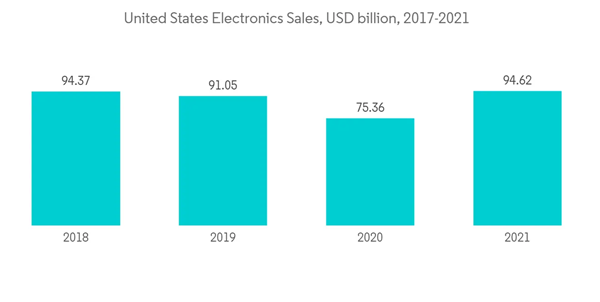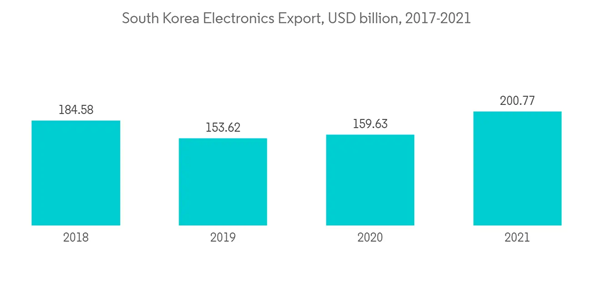The phenol derivatives market is expected to register a CAGR of over 4.5% during the forecast period.
The COVID-19 pandemic had a significant impact on the global phenol derivatives market. The pandemic disrupted the raw material supply chain, resulting in a decrease in phenol derivative production and sales. However, the market recovered with the increased demand from the automotive and construction industries for phenol derivatives in 2021. Furthermore, the growing demand for phenol derivatives from the electronics industry is expected to drive market growth.
This product will be delivered within 2 business days.
The COVID-19 pandemic had a significant impact on the global phenol derivatives market. The pandemic disrupted the raw material supply chain, resulting in a decrease in phenol derivative production and sales. However, the market recovered with the increased demand from the automotive and construction industries for phenol derivatives in 2021. Furthermore, the growing demand for phenol derivatives from the electronics industry is expected to drive market growth.
Key Highlights
- Over the short term, growing demand from the pharmaceutical industry for intermediates in the production of drugs and medicines has driven the demand for phenol derivatives.
- On the other hand, government restrictions on chemicals and the push for eco-friendly, biodegradable products are anticipated to hinder industry expansion.
- Rising demand for bio-based phenol derivatives is likely to create opportunities for the market in the coming years.
- Asia-Pacific is expected to dominate the phenol derivatives market due to the high demand for phenol derivatives from China, Japan, and India.
Phenol Derivatives Market Trends
Soaring Demand for Phenolic Resin
- In phenol derivatives, phenolic resin dominates with high demand from the industrial sector. The condensation process between phenol and formaldehyde produces phenolic resins, commonly known as phenol-formaldehyde resins. Phenolic resins are extremely resistant to heat, electricity, chemical reactions, and changes in resin form.
- Phenolic resins are utilized by numerous industries. To survive high temperatures, phenolic resin is employed as an ablative in aerospace sector rocket nozzles. It is used as an adhesive in the wood industry, as a coating material in the chemical manufacturing industries, as an abrasive in the metal industry, and as a foundry coating in the metal casting industries.
- Phenolic resin is the key ingredient for thermoplastic production, which is used in the manufacturing of electrical parts such as insulators and sockets. One of the important markets for phenolic resins is the United States, which supplies the demand from the electrical and electronics sector.
- According to the US Census Bureau, Electrical equipment, appliances, and component industry revenue in the United States were over USD 140 billion in 2021, and it was anticipated to reach USD 160 billion by the end of 2022.
- One of the main consumers of phenolic resins, which are used to make plywood and flooring panels, is the construction sector. The European Panel Federation reports that 3.2 million square meters of plywood were manufactured in 2021 and that production was anticipated to reach a record level by the end of 2022.
- Various end-user sectors, including home appliances, automotive commutators, and electrical and electronic components, frequently use molding components. Due to the compounds' outstanding dimensional stability, which is employed in the production of electrical equipment and kitchenware, the need for molding resins will continue to rise.
- Overall, it is anticipated that the phenol derivatives market will be driven by the expanding phenolic resin industry over the forecast period.
Asia-Pacific Region to Dominate the Market
- Asia-Pacific is expected to witness a high growth rate from the end-user industries, including consumer electronics, transportation, furniture, building, and construction, as well as oil and gas in China and India.
- The derivative of phenol caprolactam is used in the production of carpets, industrial fibers, and textile fibers. The Indian government stated in February 2021 that seven major textile parks would be built during the following three years. The customs duty rate on caprolactam, nylon chips, nylon fiber, and nylon yarn was reduced to 5% as part of the government's decision to rationalize the tariffs on raw materials used to make artificial textiles.
- A key raw element in the production of polycarbonate plastic is bisphenol-A. Due to its great strength and resilience to heat and electrical exposure, polycarbonate plastic is utilized in the automobile sector for a variety of goods. Helmets, headlamps, and car bumpers are a few examples of the applications.
- In 2021, China produced 26.08 million vehicles, up 3% from the 25.23 million produced in the previous year, making it the country with the greatest automotive production base in the world, according to OICA. India produced 4.4 million automobiles in 2021, a 30% increase over the 3.38 million produced in 2021 from the previous year.
- Japan's electronics industry is one of the world's largest. According to the Japan Electronics and Information Technology Industries Association (JEITA), Japan produced 10% of the world's electronics by 2021. Domestic production of electronics increased 11% Y-o-Y to more than USD 80 billion in 2021.
- The electronics industry in South Korea is among the most advanced in the world. It is a major producer of consumer electronics, semiconductors, and other electronic components on a global scale. Some of the world's largest electronics companies, such as Samsung and LG, are headquartered in South Korea. South Korea produced USD 200.77 billion in 2021, up 25% from the previous year, according to the Korea International Trade Association (KITA).
- Due to all such aforementioned factors, the Asia-Pacific-Pacific region's phenol derivatives market is anticipated to rise steadily throughout the forecast period.
Phenol Derivatives Market Competitor Analysis
The phenol derivatives market is fragmented in nature. Some of the major players in the market include Altivia, AdvanSix Inc., BASF SE, Cepsa, Domo Chemical, DIC Corporation, Fibrant, and INEOS Capital Ltd.Additional benefits of purchasing the report:
- The market estimate (ME) sheet in Excel format
- 3 months of analyst support
This product will be delivered within 2 business days.
Table of Contents
1 INTRODUCTION1.1 Study Assumptions
1.2 Scope of the Study
2 RESEARCH METHODOLOGY
3 EXECUTIVE SUMMARY
4 MARKET DYNAMICS
4.1 Drivers
4.1.1 Growing Demand from the Pharmaceutical Industry
4.1.2 Increasing Use of Phenol Derivatives in the Production of Agrochemicals, Dyes, and Other Specialty Chemicals.
4.2 Restraints
4.2.1 Stringent Environmental Regulations
4.2.2 Volatility in Raw Material Prices
4.3 Industry Value-Chain Analysis
4.4 Porter's Five Forces Analysis
4.4.1 Bargaining Power of Suppliers
4.4.2 Bargaining Power of Buyers
4.4.3 Threat of New Entrants
4.4.4 Threat of Substitute Products and Services
4.4.5 Degree of Competition
5 MARKET SEGMENTATION (Market Size in Value)
5.1 By Derivatives
5.1.1 Bisphenol-A
5.1.2 Phenolic Resin
5.1.3 Caprolactam
5.1.4 Adipic Acid
5.1.5 Other Derivatives
5.2 By Geography
5.2.1 Asia-Pacific
5.2.1.1 China
5.2.1.2 India
5.2.1.3 Japan
5.2.1.4 South Korea
5.2.1.5 Rest of Asia-Pacific
5.2.2 North America
5.2.2.1 United States
5.2.2.2 Canada
5.2.2.3 Mexico
5.2.3 Europe
5.2.3.1 Germany
5.2.3.2 France
5.2.3.3 United Kingdom
5.2.3.4 Italy
5.2.3.5 Rest of the Europe
5.2.4 South America
5.2.4.1 Brazil
5.2.4.2 Argentina
5.2.4.3 Rest of South America
5.2.5 Middle East and Africa
5.2.5.1 Saudi Arabia
5.2.5.2 South Africa
5.2.5.3 Rest of Middle East and Africa
6 COMPETITIVE LANDSCAPE
6.1 Mergers, Acquisitions, Joint Ventures, Collaborations, and Agreements
6.2 Market Share (%)**Analysis
6.3 Strategies Adopted by Leading Players
6.4 Company Profiles
6.4.1 AdvanSix Inc.
6.4.2 Altivia
6.4.3 BASF SE
6.4.4 Cepsa
6.4.5 DIC Corporation
6.4.6 Domo Chemcial
6.4.7 Fibrant
6.4.8 Fujian Yongrong Jinjiang Co. Ltd
6.4.9 INEOS Capital Ltd
6.4.10 Mitsubishi Chemcial Corporation
6.4.11 Mitsui Chemcials Inc.
6.4.12 PTT Phenol Company Limited
6.4.13 Shell PLC
6.4.14 Solvay SA
7 MARKET OPPORTUNITIES AND FUTURE TRENDS
7.1 Growing Demand for Bio-based Phenol Derivatives
Companies Mentioned (Partial List)
A selection of companies mentioned in this report includes, but is not limited to:
- AdvanSix Inc.
- Altivia
- BASF SE
- Cepsa
- DIC Corporation
- Domo Chemcial
- Fibrant
- Fujian Yongrong Jinjiang Co. Ltd
- INEOS Capital Ltd
- Mitsubishi Chemcial Corporation
- Mitsui Chemcials Inc.
- PTT Phenol Company Limited
- Shell PLC
- Solvay SA
Methodology

LOADING...










